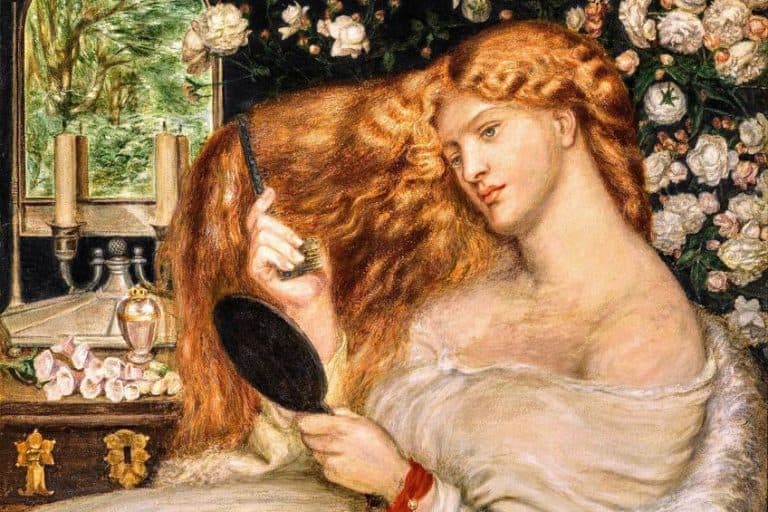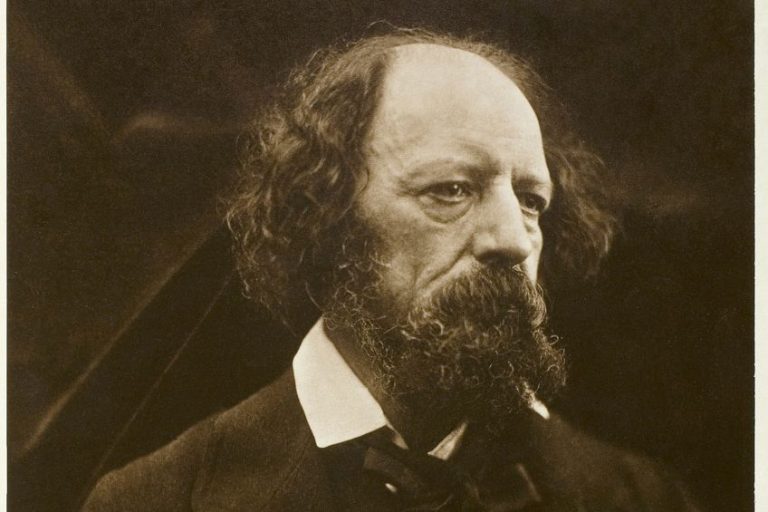What Is Slam Poetry? – The Power of Poetry in Protest
Have you ever heard of slam poetry, the powerful and unconventional poetry style that does not rely on publishing or the written page, but delivers emotion and power through spoken word on stage? Look no further, because in this article, we will discuss all things slam, from its origin stories to how to write and perform your own slam poem. Let’s dive in!
The Definition of Slam Poetry
What is slam poetry? It is a type of performance poetry that blends writing, performance, and competition together, and incorporates participation from the audience. The title ‘slam’ comes from the high energy with which the poets perform their poetry, as well as from the power the audience has to either destroy a poem or praise it. The types of events at which this poetry form takes place are called slams or poetry slams.
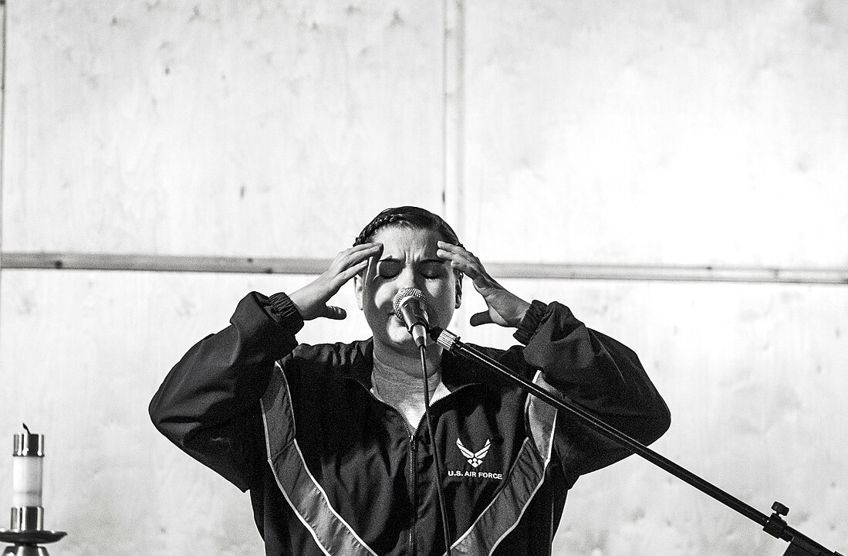
Origin and History of Slam Poetry
Before we take a look at what is a slam poem, let us unpack its origins. The roots of slam Poetry can be traced back to oral traditions thousands of years ago. It has also been connected with the Négritude movement, which was led by French-speaking black writers from the French colonies in the 1930s in the Caribbean and Africa. These writers who were mainly living in Europe and France were inspired by the Harlem Renaissance, a cultural and intellectual comeback of African-American art, music, dance, literature, theater, and politics. This influenced their exploration into important social matters, such as culture, social oppression, the African diaspora, and colonization, and it is this emphasis on social issues that sets slam apart from other forms of poetry. Later, this oral tradition was reignited by poets in the United States who worked with similar themes, dealing with issues of gender, race, injustice, and so on.
Clubs became well-known for hosting acclaimed slam poetry events, such as the Nuyorican Poets Café in New York, for example.

The origins of slam poetry as we know it today has been attributed to Marc Kelly Smith (1949 – present) who lived in Chicago, Illinois and worked in construction. As a local poet in the area, he felt that poetry and poetry readings had lost their fervor, and began an event in the 1980s that took place every week where anyone could take part – poetry slams. Here, poets would be judged on a scale from zero to ten on their poetry performance by five audience members selected at random. The lowest and the highest scores were taken away out of the five, and the three remaining scores were added together for the total score. At the end of the event, the poet who had earned the highest score won the competition. In 1990, the first National Poetry Slam was held and since then it has become a yearly event in which teams from throughout the United States come together to compete in a host city.
Importance of Slam Poetry in Modern Society
Today, slam poetry is an established genre of poetry and a respected art form and artistic movement. The Louder Than a Bomb festival in Chicago is the biggest festival for youth poetry on the globe. The movement has spread and inspired people from many parts of the world like Canada, the United States, Japan, and Europe to create hundreds of poetry slams.
Slam poets have also affected many elements of modern culture, influencing art, media, literature, political movements, and entertainment.
The Art of Slam Poetry
What makes slam poetry unique is that it does not depend on written poetry on paper for its influence and force. Poets evoke emotion in their audience with the use of their own energy and emotion, use of language, and enthusiastic delivery, compared to more traditional poetry methods.
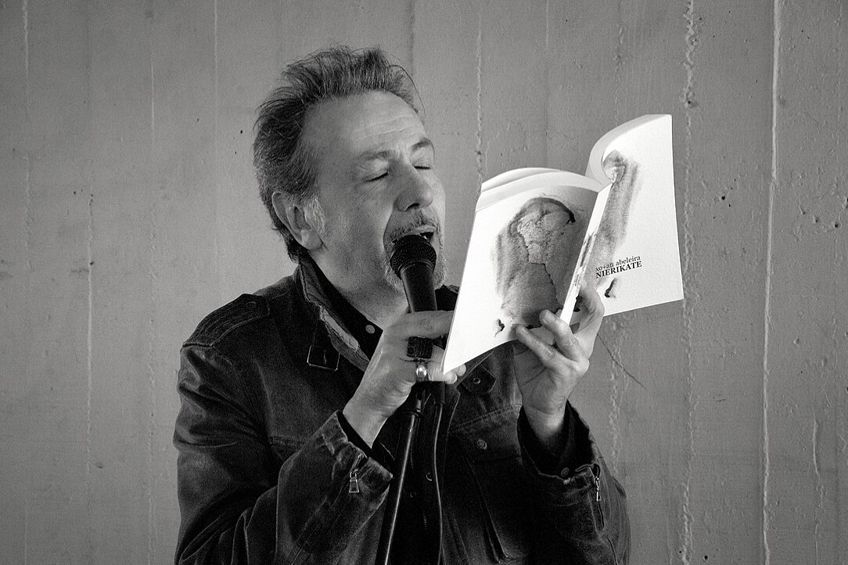
Understanding the Performance Aspect of Slam Poetry
Performance is a majorly important part of slam poetry. Rather than reading a poem, the audience can listen to the spoken poetry by the poet themselves, making it more personal and allowing the poet to express their poem the way that they intended it to be received. The face of the protagonist in a piece is often the poet, and therefore a strong relationship between the poem and themselves is created, further making it more gripping for the audience. Before written language, people expressed themselves through spoken word.
Poetry was born as an oral tradition and its history is filled with oral storytelling.
Elements of Slam Poetry Performances
There are various elements that go into a slam poetry performance. The aim of this style of poetry is to provoke, to stoke the fire in the audience, and to trigger an emotional response. Poets choose words for their meaning and also for how they sound when spoken, allowing the speaker to emphasize certain words or sounds for impact. Furthermore, written poetry may use a device such as lineation, while silence or breaks may be used by slam poets as a device.

Another element of these performances is that there are no costumes or props allowed, which means that acting comes into play. The poet has to use their facial expressions and bodily movements to make their performance impactful. Some may use voice dynamics, like speaking in a whisper and then shouting, or even pace up and down, walking slowly and then speed up, or vice versa, for dramatic effect.
Writing Slam Poetry
As you may have picked up, slam poetry is very different from other styles of poetry, and therefore it would have a different way of writing too. Below we have listed some tips on writing a slam poem and answering questions like does slam poetry have to rhyme, as well as advice on performance and common themes.
Here are some tips for writing your own slam poetry.
- The first tip in writing a slam poem would be to witness a poetry slam for yourself. There are many videos and examples online for you to watch, or you could attend one in your area which would give you a better feel for the connection between the poet and the audience. Experiencing it for yourself will help you understand what slam involves.
- Select a topic that will resonate with the audience and inspire a response from them. Thinking about the venue and geography will reveal what will cater to them the most. Since you would be performing the poem for an audience who would then score you, telling an impactful story will help. Think of writing about a topic or subject that you are passionate about or have strong emotions towards. Common themes in slam poems are current events, sexism, racism, gender, and more.
- Write your feelings down after you have chosen your topic. This piece of writing does not need to be neat and organized at first. A rough draft is what you need at this point, so that you can select the thoughts that resonate most and refine it.
- Next, you can give the writing some rhyme. Using rhyme schemes and rhythms can give a poem a more hip-hop vibe. But does slam poetry have to rhyme? The answer is that there are no restrictions. There is no need for slam poetry to have a formal structure and many poets are drawn to the kind of freedom that slam poetry offers. Most slam poets write in free-verse, but it is still important to think about how the poem will sound when read aloud. It needs some kind of rhythm. You can do this by using repetitive sounds and alliteration, or by changing word order and choosing words that will create emphasis.
- Now that you have written your poem, it is time to trim it. Your poem cannot take longer than three minutes to perform. In fact, under three minutes is ideal. Therefore, you need to keep your audience’s attention for that short amount of time. Remove any words or sentences that are not essential to the meaning of the poem. You could test yourself by reading aloud and timing yourself.
- The final step would be to plan out your performance and practice until you are happy with it. It may even help to ask a friend or family member to act as your audience and give you their feedback. We will cover this part in more detail below.
Techniques for Delivering Powerful Performances
When performing your slam poem, you want to think about how you would feel being in the audience receiving the poem. How would you be impacted by it and what actions or words would stand out to you? You can create impact in your performance by pausing to highlight a certain phrase or word, slowing down or speeding up certain passages, using your hands to make gestures and moving your body, making expressions with your face, or even clapping a rhythm or stamping your feet.

Remember that when you go on stage, you need to have your poem memorized so that you can fully engage with the audience. Practice your poem over and over again, developing the confidence needed to give a powerful delivery on stage. A personality that is confident and lively will help you to give a better performance and the audience will enjoy listening. Nerves are normal when performing, so try breathing exercises and clearing your mind on the competition day to help you to relax and stay calm. Remember that it is also okay to lose, this will take some of the pressure off you. Performing a slam poem is meant to be fun, you are sharing your voice and art with the world, and enjoy the experience.
The Slam Poetry Community
The groups of people that come together at any poetry event have a love of poetry and the written word in common and the same would go for slam poetry. In this case, however, it is more than poetry but also a passion for certain social issues and progressive politics. By taking part in this community, poets build networks and create friendships and allies through artistic connection, emotions, and experience.
These communities allow poets to build organizational structures with the goal of maintaining and sustaining their art and activism.
Given that the status of slam poetry lives on the border of the art world, certain initiatives give ways for poets to share and spread their work, to refine their craft, and add professional legitimacy to their work. These initiatives include workshops organized by the poets themselves, slam events and open mic nights, organizing award ceremonies, and creating, publishing, and selling chapbooks, a small publication of their poetry consisting of about 40 pages. The community also gets involved in mentoring the next generation of writers and poets by coaching teen slam groups, assisting with youth poetry workshops, and creating opportunities for up-and-coming poets to perform.
The Competitive Nature of Slam Poetry
By its nature, slam poetry is competitive as poets perform their poem against other competing poets in front of an audience. Each performance is expected to be original and each one is scored. This is usually done by five members of the audience chosen at random by the host of the event or master of ceremonies. These members judge the performance on a scale from zero to ten.

The lowest and the highest scores are then taken away out of the five, and the three remaining scores are added together for the total score. At the end of the event, the poet who has earned the highest score wins. The competitive pressure of the event gives the poet the extra push to make their poem as engaging and unique as possible, to create something that will enthrall their audience.
Opportunities to Perform or Watch Slam Poetry
If you have never witnessed a slam poetry event, you may be thinking that they would be quite difficult to find. There are many live slam poetry events online, and there may even be an event taking place closer to you than you think.
If you are looking for places to perform or watch slam poetry, we have listed some sources below.
- Local newspapers or town brochures would advertise these sorts of events. Flip through a couple and you may find an upcoming slam event in your town or close by. Invite a few friends to go along with you.
- The Academy of American Poets has a database called Poetry Near You that you can use to find poetry events in your area.
- You can become a participant in the international slam poetry competition, Brave New Voices by registering on their website.
- org is another great source to use for workshops, poetry readings, and events.
- You can also do a simple search on the internet for slam poetry events near you.
Slam Poetry and Social Justice
As outlined earlier in the article, the topics of slam poetry tend to be political or focused on social issues. It therefore has an impact on social justice movements and intersects with activism. It does this through empowering and influencing people through spoken word, opening their eyes to topics and ideas they have not given much thought to before. By exposing the audience to different individual experiences and perspectives, poetry slams are a driving force for social change and the restructuring of belief systems.

Poetry slams are platforms that poets can use to advocate for certain issues and to bring awareness to those issues, and also to build networks of people within a community who seek change. The stories told in slam Poetry can for that reason act as a tool for activism, inviting people to become part of movements.
Poetry as a whole is often used during times of crisis and has been part of Black Lives Matter, women’s liberation, and civil rights movements, amongst others.
Examples of Slam Poetry Addressing Social Issues
There are many examples of slam poetry performances available to watch, and we cannot list all of them, but we have listed some examples that address social issues below by some of the best-known slam poets.

What Kind of Asian Are You Rush by Alex Dang (2013)
| Poem Title | What Kind of Asian Are You |
| Poet | Alex Dang |
| Year Performed | 2013 |
| Slam Poetry Event | United States National Poetry Slam |
What Kind of Asian Are You (2013) full poem:
“So he said to me: ‘What kind of Asian are you? ‘
And I said back: Well that’s a loaded question, what do you expect me to be?
Because any way slice that egg-roll I’m still pretty much what you want to see
I’ve played many a far east stereotype
Awkward math genius
Cold and calculated Kung-Fu expert
Assistant to ‘Dr Jones, you crazy! ‘
You want me to drive, how so?
I can give you Tokyo drift, Jeremy Lin, Mario Kart, Tiger woods and…
Blinker left on for almost half a mile
I am the foremost expert on all things Asian
The Meiji Era and the ban of the Samurai? Done.
Confucianism versus Daoism? I’ll give it to you with no slant.
What’s the difference between Asian cereal type one and two?
Well, let me tell you,
let me tell you everything you want to know about my culture
let me tell you in a Mulan-esque soliloquy staring at the mirror asking:
‘Who is that girl that I see! ‘
Let me tell you about Jackie Chan and about Bruce Lee,
and about how they’re related-by blood- to me
Let me tell you about being so marginalized, it’s to the point of ‘I really can’t believe that’s Asian! ‘
Let me tell you about derogatory terms and origins of words such as: chink and gook
let me tell you about the struggle of Asian parents not knowing the language,
so we,
Ate pet food because it was cheaper
Let me tell you about the job of interpreter
When you’re still playing with Lego blocks but you’re English is already that much better than your parents
Let me tell you about honor and dignity
Let me tell you about a society that projects us as nothing but the secondary role and never the leading man
Let me tell you all the things you don’t want to know
like how chink,
comes from the clinking of metal to railroad as the slaves built train-tracks for this country to be connected
Like how the ‘zipper head’ down the street is called that because the way out heads split open-
when struck with assault weapons
or how,
Jeeps, ran over and left marks across corpses
and how someone clever thought that we were only good to unzip
Or like how,
Every time you lump an Asian person into one culture
it systematically making us assimilate
into an america we thought was better than our war torn home
and every time you confuse me
with some other nationality that I might share similar features to
Is stripping away my individuality
and I still
feel the shame of being Asian
the heat and pious dedication of June 11,1963
the envy of blond hair and blue eyes
and I still
remember thinking where all the boys who look like me, on TV, were
the broken words from my mother and father
stage diving off of my tongue
the anger i felt when those kids thought I would get them sick
and I still
feel the ash of the incense burn my hand when i pray;
for my family
and I still
remember thinking my skin was what i was worth
and I still
Feel the iron work of my bones grow stronger with every train of thought
that passes by
and I still
feel pride
and I still
feel heritage
and I still
feel chinese
and I still
Feel Vietnamese
and I still
Feel American
and I still
Feel.”
Joey by Neil Hilborn (2015)
| Poem Title | Joey |
| Poet | Neil Hillborn |
| Year Performed | 2015 |
| Slam Poetry Event | Button Poetry |
Extract from Joey (2015):
“When I wanted to
open myself up and see if there really were
bees rattling around in there, my parents got me
a therapist. I can pinpoint the session
that brought me back to the world. That session
cost seventy-five dollars. Seventy-five dollars
is two weeks of groceries. It’s a month of bus fare.
It’s not even a school year’s worth of new shoes.
It took weeks of seventy-five dollars to get to the one
that saved my life. We both had parents that believed
us when we said we weren’t OK, but mine could afford
to do something about it. I wonder how many kids
like Joey wanted to die and were unlucky enough
to actually pull it off. How many of those kids
had someone who cared about them but also
had to pay rent?”
Hair by Elizabeth Acevedo (2016)
| Poem Title | Hair |
| Poet | Elizabeth Acevedo |
| Year Performed | 2016 |
| Slam Poetry Event | Women of the World Poetry Slam |
Extract of Hair (2016):
“They say Dominicans can do the best hair.
I mean they wash, set, flatten the spring in any loc
but what they mean is we’re the best at swallowing amnesia,
in a cup of morisoñando, die dreaming because we’d rather do that than live in this reality, caught between orange juice and milk,
between reflections of the sun and whiteness.
What they mean is, ‘Why would you date a black man?’
What they mean is, ‘a prieto cocolo’
What they mean is, ‘Why would two oppressed people come together? It’s two times the trouble.’
What they really mean is, ‘Have you thought of your daughter’s hair?’
And I don’t tell them that we love like sugar cane, brown skin, pale flesh, meshed in pure sweetness.”
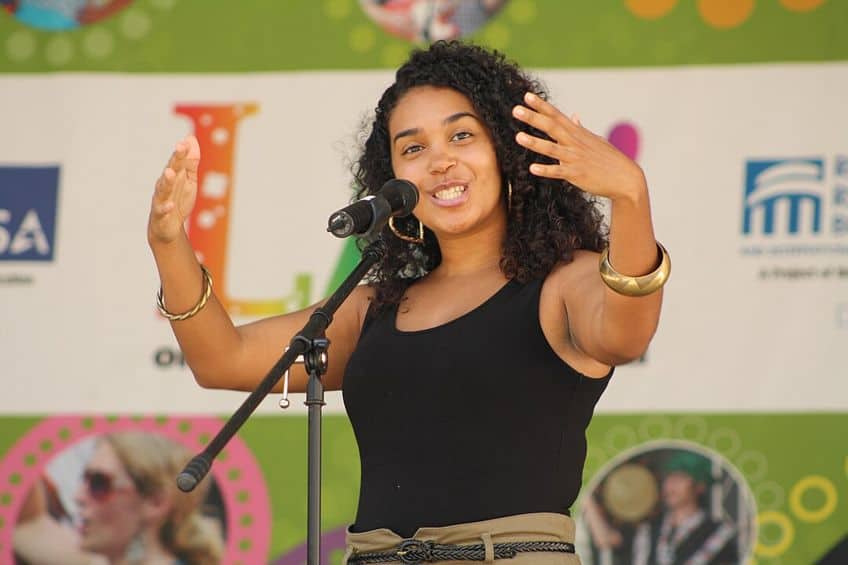
Pocket-Sized Feminism by Blythe Baird (2016)
| Poem Title | Pocket-Sized Feminism |
| Poet | Blythe Baird |
| Year Performed | 2016 |
| Slam Poetry Event | Button Poetry |
Pocket-Sized Feminism (2016) full poem:
“The only other girl at the party
is ranting about feminism. The audience:
a sea of rape jokes and snapbacks
and styrofoam cups and me. They gawk
at her mouth like it is a drain
clogged with too many opinions.
I shoot her an empathetic glance
and say nothing. This house is for
wallpaper women. What good
is wallpaper that speaks?
I want to stand up, but if I do,
whose coffee table silence
will these boys rest their feet on?
I want to stand up, but if I do,
what if someone takes my spot?
I want to stand up, but if I do,
what if everyone notices I’ve been
sitting this whole time? I am guilty
of keeping my feminism in my pocket
until it is convenient not to, like at poetry
slams or my women’s studies class.
There are days I want people to like me
more than I want to change the world.
There are days I forget we had to invent
nail polish to change color in drugged
drinks and apps to virtually walk us home
at night and mace disguised as lipstick.
Once, I told a boy I was powerful
and he told me to mind my own business.
Once, a boy accused me of practicing
misandry. ‘You think you can take
over the world?’ And I said ‘No’,
‘I just want to see it’. I just need
to know it is there for someone.
Once, my dad informed me sexism
is dead and reminded me to always
carry pepper spray in the same breath.
We accept this state of constant fear
as just another part of being a girl.
We text each other when we get home
safe and it does not occur to us that our
guy friends do not have to do the same.
You could saw a woman in half
and it would be called a magic trick.
That’s why you invited us here,
isn’t it? Because there is no show
without a beautiful assistant?
We are surrounded by boys who hang up
our naked posters and fantasize
about choking us and watch movies
we get murdered in. We are the daughters
of men who warned us about the news
and the missing girls on the milk carton
and the sharp edge of the world.
They begged us to be careful. To be safe.
Then told our brothers to go out and play.”
Adrenaline Rush by Rudy Francisco (2017)
| Poem Title | Adrenaline Rush |
| Poet | Rudy Francisco |
| Year Performed | 2017 |
| Slam Poetry Event | Individual World Poetry Slam Finals |
Extract of Adrenaline Rush (2017):
“Once, a friend of a friend asked me
why there aren’t more black people in the X Games
and I said, ‘You don’t get it.’
Being black is one of the most extreme sports in America.
We don’t need to invent new ways of risking our lives
because the old ones have been working for decades.”
The Future of Slam Poetry
There are emerging trends in slam poetry that can be noted. For example, poetry has been appearing on social media platforms like Facebook, Instagram, and TikTok. The slam poetry structure is also changing and evolving, experimenting with new techniques and verse-forms.
To better impact and engage with a particular audience in a geographic setting, some poets have started using colloquialisms and slang words.
The Role of Technology in the Future of Slam Poetry
As the world and society as a whole is changing, so too must slam poetry evolve with it. A big part of this progress is the use of technology. Many people regularly use cellphones, laptops, and the internet to watch performances and videos, and this makes it easier to watch slam performances in real-time or events that have already finished. Technology therefore makes slam poetry more accessible to the masses. Information is available online to find events, and videos are shared across various platforms from YouTube to Instagram, spreading awareness of slam poetry.

Potential for Slam Poetry to Continue to Influence Culture
Poetry has had an impact on culture for centuries, and there is great potential for slam poetry to continue to influence culture. As a powerful medium, it has changed lives with events like Louder Than a Bomb which takes place in Chicago. Its competitive nature and versatile structure keeps the art form fresh, entertaining, and current.
And that’s the end of our article about what is slam poetry. We hope that you enjoyed learning about this poetry form just as much as we did. The versatility of slam poetry’s structure, its inclusive culture, and the way in which it impacts people on an individual and collective level means that slam poetry has a great chance in continuing to influence culture. Hopefully, you are inspired to attend an event or to even write your own powerful slam poem!
Frequently Asked Questions
What Is a Slam Poem?
A slam poem is written to be performed as part of a competition that incorporates participation from the audience. The types of events at which this poetry form takes place are called slams or poetry slams. Slam poems often focus on subjects like social issues and can therefore be a form of activism.
What Sets Slam Poetry Apart from Traditional Poetry?
While traditional poetry is known for being presented on paper, slam poetry is an oral tradition and is meant to be performed to a live audience. Slam poetry is also done as part of a competition, while traditional poetry is not judged in this way.
Can Anyone Perform Slam Poetry?
Slam poetry is highly democratic, meaning that anyone can perform and compete. Although rules may vary depending on the location or event, poetry slams always follow this principle: That anyone, regardless of sex, age, gender, race, physical ability, educational background, or sexuality, can compete in any slam poetry competition.
Jaycene-Fay Ravenscroft is a writer, poet, and creative living in South Africa with over 6 years of experience working in a contemporary art gallery. She completed her Bachelor of Arts degree, majoring in Art History and Ancient History at the University of South Africa, with additional subjects in Archaeology and Anthropology.
With a passion for learning, Jaycene-Fay is very much inspired by symbology and the connection between everything in this world. Trained to analyze and ‘critique’ art, she is passionate about exploring the meaning behind each artwork she encounters and understanding how it connects to the artist’s cultural, historical, and social background. Writing is Jaycene-Fay’s way of having a finger in every pie: to research, share knowledge, and express herself creatively.
Learn more about Jaycene-Fay Ravenscroft and the Art in Context Team.
Cite this Article
Jaycene-Fay, Ravenscroft, “What Is Slam Poetry? – The Power of Poetry in Protest.” Art in Context. November 24, 2023. URL: https://artincontext.org/what-is-slam-poetry/
Ravenscroft, J. (2023, 24 November). What Is Slam Poetry? – The Power of Poetry in Protest. Art in Context. https://artincontext.org/what-is-slam-poetry/
Ravenscroft, Jaycene-Fay. “What Is Slam Poetry? – The Power of Poetry in Protest.” Art in Context, November 24, 2023. https://artincontext.org/what-is-slam-poetry/.





